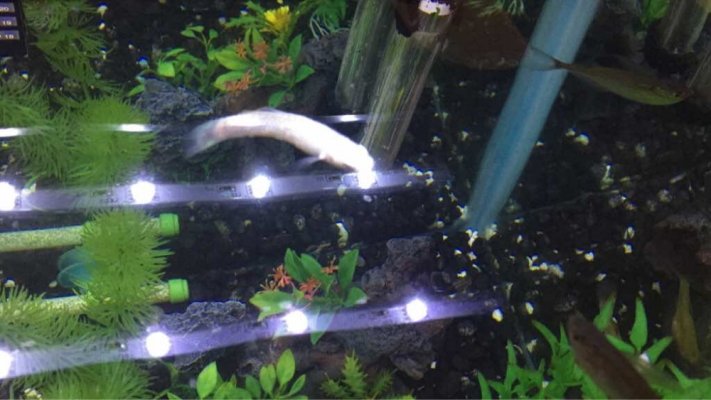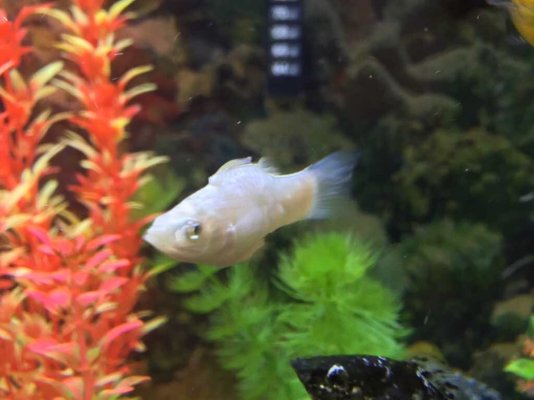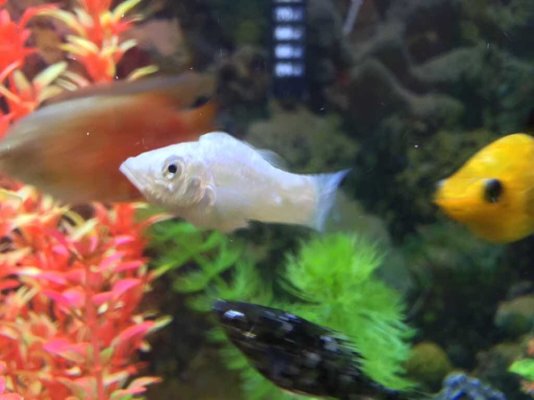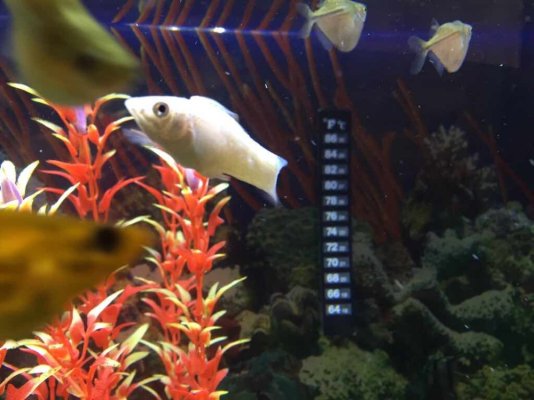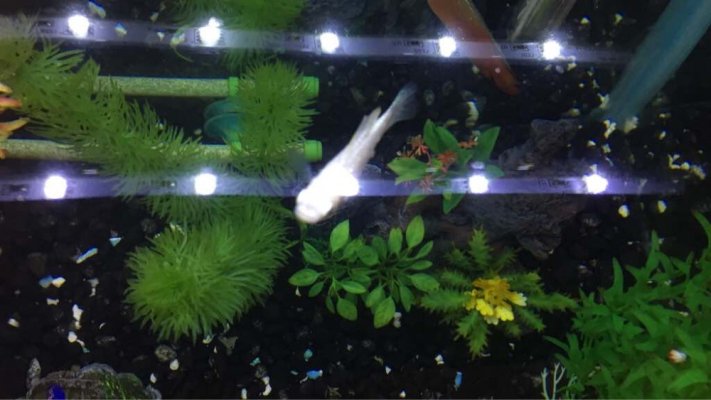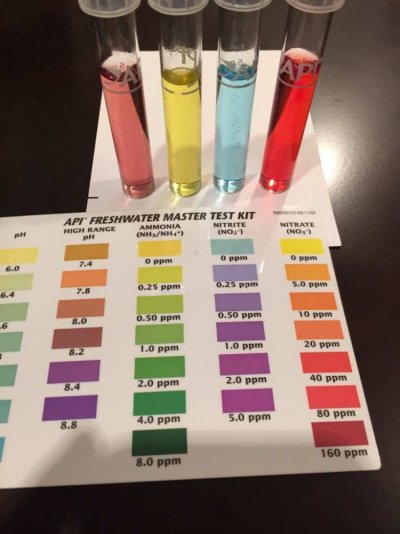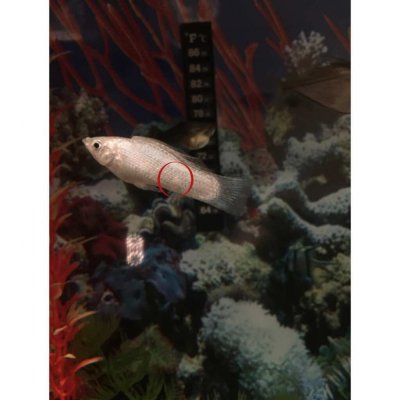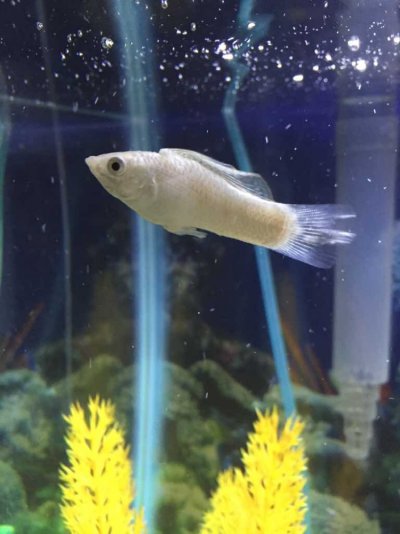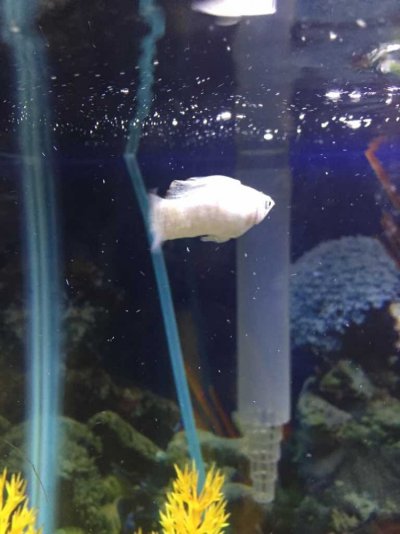You are using an out of date browser. It may not display this or other websites correctly.
You should upgrade or use an alternative browser.
You should upgrade or use an alternative browser.
Mollie with blisters??
- Thread starter sparker24
- Start date
The friendliest place on the web for anyone with an interest in aquariums or fish keeping!
If you have answers, please help by responding to the unanswered posts.
If you have answers, please help by responding to the unanswered posts.
ImACoolguy
Aquarium Advice Addict
It's very hard to see.
What are your water parameters?
Caleb
What are your water parameters?
Caleb
Still struggling a bit. Do you mean like an actual blister with clear liquid inside? And the blisters are all over?
Or more like a white patch on the scales?
I assume no flashing?
Or more like a white patch on the scales?
I assume no flashing?
ImACoolguy
Aquarium Advice Addict
Nonetheless I'd start with a water change to bring those nitrates under 20ppm.
Caleb
Caleb
Nonetheless I'd start with a water change to bring those nitrates under 20ppm.
Caleb
Good point very red there in test.
It's late
I'd go with tetra fungus guard to treat a bacterial infection but it also covers fungal.
http://m.petsmart.com/h5/hub?id=htt...atment-zid36-5016503/cat-36-catid-300044?null
sinibotia
Aquarium Advice Addict
Agreed with Caleb, fixing the nitrates is your best 1st step.
Still can't find the link to see if it matched  . May be on desktop, will look tonight.
. May be on desktop, will look tonight.
Assuming there was no persistent flashing or scratching (?), my other thought was fungal (so hedged bets with fungus guard). Wondered if the temp has changed in tank or if it has been stable temp (including after water changes)? Also has anything changed in tank recently?
Assuming there was no persistent flashing or scratching (?), my other thought was fungal (so hedged bets with fungus guard). Wondered if the temp has changed in tank or if it has been stable temp (including after water changes)? Also has anything changed in tank recently?
There is no flashing or scratching that I have seen. The temperature has remained the same for the most part, small fluctuations but nothing dramatic. I have added a couple of fake plants but it doesn't seem to effect the other fish.
Is there a way to post a link to a video or post a video?
Is there a way to post a link to a video or post a video?
Jessy2363
Aquarium Advice Activist
Other than nitrates the weird blister things look parasitic. The way they are sparsely placed al over the body is quite bizarre which tells me it's parasitic.
Have you done a salt dip yet?
Have you done a salt dip yet?
ImACoolguy
Aquarium Advice Addict
I'll be honest. I am not sure what a salt dip is. I am pretty new to all of this. Salt has been something that I don't understand enough of so I haven't dared to try it.
1 tablespoon of salt per 5 gallons. This is best done in a quarantine tank but if you have no inverts such as snails or live plants you should be fine.
What aquarium salt does is stress the fish. By stressing them, it builds up their slime coat making them more resistant to disease. Salt should only be used in the process of medicating as long term it has shown to have health issues on the fish such as kidney problems.
Caleb
Other than nitrates the weird blister things look parasitic. The way they are sparsely placed al over the body is quite bizarre which tells me it's parasitic.
Have you done a salt dip yet?
I'm missing how body placement relates solely to parasites? If you can explain more? Just curious.
Last edited:
Jessy2363
Aquarium Advice Activist
I'm missing how body placement relates solely to parasites? If you can explain more? Just curious.
normally a bacterial infection will start in a certain spot and spread from there like a crawling plant. Parasites can move and crawl and will often place themselves around the body in random places. Like fish lice for example. Parasites imbed themselves under the slime coat of the fish and seem to be more sporadically placed then bacteria. Notice how the sores don't touch one another as if each sore has its own territory. These things look sort of look like they are identical in shape meaning there is more than 1 of whatever this is. Bacteria is not likely to emulate its shape of how it attacks. See how the sores look identical to each other like the same breed of parasite has gone about its business in the same way in each spot. It's like a heap of sores on the fish where something has sort of drilled into it. Like a clan of parasites marking their spot. I just get the feeling this is parasitic due to that. Look at the parasitic worm that attacks human's called ring worm. It plants itself around the body of the human host in no specific spot and they don't usually collide with one another. I'm not saying it definitely is parasitic but it just doesn't look bacterial IMO. But of course I could be wrong. I am not claiming to be correct as I'm not a fish doctor although I read a lot.
Bacterial infections often start in the gills and around the mouth also or directly on top of the back or open wounds. These sores could turn bacterial though as the flesh is exposed and skin is broken opening the fish up to bacteria and viruses and especially fungus as that will latch onto anything slightly not right.
In saying all this, there is a bacteria that could be responsible and that's the bacteria that causes haemorrhagic septicaemia. Lesions, ulcers or sores on the body, reddening at the base of the fins and the vent, loss of appetite and darkening of coloration are all symptoms. That's when the bacteria is internal and is breaking out of the body causing the leisions. The fish needs antibiotics for a long duration.
Jessy2363
Aquarium Advice Activist
1 tablespoon of salt per 5 gallons. This is best done in a quarantine tank but if you have no inverts such as snails or live plants you should be fine.
What aquarium salt does is stress the fish. By stressing them, it builds up their slime coat making them more resistant to disease. Salt should only be used in the process of medicating as long term it has shown to have health issues on the fish such as kidney problems.
Caleb
Interesting point there ImACoolguy. I didn't know that the reason the slime coat of a fish builds up from salt is due to salt stressing them. Although no doubt it does when added very quickly in order to shock/stress the fish.
I have read statements that say salt reduces stress at relatively low levels due to making the water more buoyant therefore less osmotic pressure on the fish. (I can't state whether that is true as I don't remember where I read it) I have also read that high concentrations of salt can strip the layer of slime coat on the fish making the parasites/bacteria literally fall off and explode due to not having the necessary pressure (gravity) to even stay in one piece. Imagine if you sent a human into space where there is no gravity. Even our skin couldn't keep us in one piece and we would literally start turn inside out as our bodies are not accustomed to that level of gravity.
Depending on what you are trying to do determines whether you do a highly concentrated salt dip or a low dosed salt bath. I'd probably do both as a quick high concentrated dip is going to strip the parasites off giving immediate relief. Particularly with a molly as they are brackish. A Molly could easily withstand anywhere between 20 minutes to 2 hours in a 3% salt solution (actual seawater). The benefits would be very beneficial for this fish in particular.
20 Tablespoons per 10 litres gives you that concentration if you are not near the sea. And the post above gives the low dose amount. Molly's could live with this amount happily.
Last edited:
Jessy2363
Aquarium Advice Activist
I'll be honest. I am not sure what a salt dip is. I am pretty new to all of this. Salt has been something that I don't understand enough of so I haven't dared to try it.
Sorry have done too many replies lol. Sorry all if you're sick of listening to me. In short: 20 Tablespoons of aquarium salt per 10 litres. Dip the fish in till it rolls over. Make sure it's the same temp as the aquarium you pulled it out of. And dissolve the salt first of course.
Similar threads
- Replies
- 9
- Views
- 456
- Replies
- 4
- Views
- 222
- Replies
- 4
- Views
- 218

